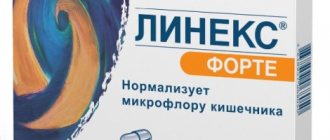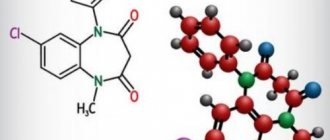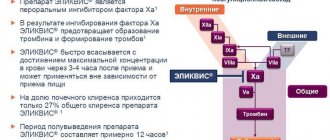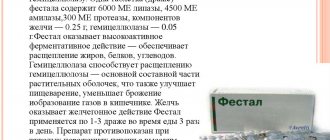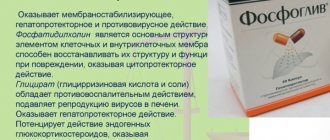Gastal is a combined antacid drug that helps cope with high acidity in the stomach. Prescribed for children from the age of six. There are contraindications that should not be ignored to avoid adverse reactions. Before starting the course, it is recommended to take into account drug interactions. The product has an average cost of 190–510 rubles. The price depends on the packaging. The selection of analogues of Gastal cheaper for heartburn is carried out exclusively by a gastroenterologist.
Indications for use of Gastal
Gastal is prescribed to patients with the following pathologies and disorders:
- Dyspeptic symptoms that occur as a result of drinking alcohol, coffee, smoking, and taking certain groups of medications.
- Stomach ulcer.
- Gastritis.
- Reflux esophagitis.
- Hiatal hernia.
The drug is not recommended for patients under 6 years of age and older age groups (over 65 years), as well as during pregnancy and breastfeeding. Before starting a course of treatment in children, the total body weight must be taken into account.
Indications and contraindications for use
The drug is prescribed for the following pathological processes:
- Heartburn of various etiologies - after taking other medications, errors in diet
- Stomach and duodenal ulcers
- Inflammatory processes in the gastrointestinal tract
- Reflux disease
- Diaphragmatic hernia
The antacid is not used in the following cases:
- History of kidney disease
- Alzheimer's disease
- Reducing the concentration of phosphorus salts in the blood serum
- Lactose intolerance, pathologies associated with the metabolism of glucose and other sugars in the body
- Individual intolerance to the components of the antacid
- Children under 6 years old
- Pregnancy is a relative contraindication. If the benefit to the mother is greater than the expected harm to the child
- Elderly age - use with caution and as prescribed by a doctor
Gastal - instructions for use
According to the instructions for use, Gastal is recommended to be absorbed in the oral cavity. The dosage depends on the diagnosis and the age category of the patient:
- Adults and children over 12 years of age (weight over 50 kg): 2-4 tablets 4-6 times a day, 60 minutes after meals, and also before bedtime. The duration of the course is 14 days.
- Heartburn (adults and children over 12 years of age): 2-4 tablets 4-6 times a day, regardless of meals. The duration of the course is 14 days.
- Children over 12 years old (weight less than 50 kg), as well as from 6 to 12 years old: 1–2 pcs. 2–3 times a day. The duration of the course is no more than 14 days.
How to take Gastal: before or after meals
Gastal is recommended to be taken 50–60 minutes after meals. This helps reduce the production of hydrochloric acid in the stomach and alleviate the condition. As for taking the drug for heartburn, it is absorbed regardless of meals.
Gastal
Gastal ®
(lat.
Gastal ®
) is an antacid drug intended for the treatment of diseases of the digestive tract, the mechanism of action of which is based on the neutralization of gastric acid. According to the pharmacological index, gastal belongs to antacids and adsorbents. For ATC - to the group of antacids, subgroup “Antacids in combination with other drugs”, code A02AX.
Composition of the drug Gastal
Active substances:
one tablet of gastal contains 450 mg of hydrotalcite and 300 mg of magnesium hydroxide.
Excipients
(for the drug in tablets): mannitol, sorbitol, lactose, corn starch, sodium cyclamate, sodium saccharinate, talc, magnesium stearate, peppermint flavor.
Gastal release forms
- pills
- cherry lozenges
- mint lozenges
Pharmacological action of Gastal
Gastal is a combined antacid drug for oral administration.
Reduces the increased acidity of gastric juice to a physiological level and eliminates dyspeptic disorders by neutralizing excess hydrochloric acid in the stomach. The magnesium hydroxide and aluminum hydroxide included in gastal provide rapid and long-term neutralization, causing an antacid effect. The antacid effect of the drug appears immediately after taking Gastal tablets and lasts about 2 hours. 1 tablet of gastal neutralizes about 21.5 mmol of hydrochloric acid. Gastal inhibits the action of pepsin, lysolecithin and bile acids, thus also eliminating gastric dysfunction. Gastal, in addition to its antacid effect, activates protective and regenerative mechanisms in the gastric mucosa. The cytoprotective effect caused by aluminum ions includes stimulation of the secretion of mucus and sodium bicarbonate in the stomach, the accumulation of epidermal growth factor at the site of damage, an increase in the concentration of phospholipids in the stomach and other mechanisms.
Gastal has no systemic effect in patients with normal renal function. After interacting with the hydrochloric acid of gastric juice, aluminum hydroxide reacts with phosphates and carbonates in the alkaline environment of the intestine and is excreted in the feces in the form of insoluble salts. Magnesium hydroxide reacts with hydrochloric acid in gastric juice to form magnesium chloride, which has an osmotic laxative effect in the small intestine. Magnesium is also excreted in the feces as insoluble carbonate.
Indications for use of Gastal
Heartburn (after taking medications, alcohol, coffee; dietary errors, nicotine abuse, etc.); conditions accompanied by increased acid formation: gastritis, gastric and duodenal ulcers; symptomatic ulcers of various origins; erosion of the gastric mucosa of the upper gastrointestinal tract; reflux esophagitis; hiatal hernia; acute pancreatitis, exacerbation of chronic pancreatitis (as part of combination therapy). Fermentative or putrefactive dyspepsia (as part of combination therapy).
Contraindications to the use of Gastal
Hypersensitivity, chronic renal failure, Alzheimer's disease, hypophosphatemia, children under 6 years of age. With caution: children under 12 years of age. During lactation and pregnancy, only as prescribed and under the supervision of a physician.
Method of administration of Gastal and dose
Gastal is taken orally. The Gastal tablet should be dissolved gradually (do not swallow whole). Adults are recommended to take Gastal an hour after meals and before bedtime, 1-2 tablets 4-6 times a day, but not more than 8 tablets within 24 hours. The duration of taking Gastal should not exceed 2 weeks. For prophylaxis, Gastal is used before the expected irritant effect on the mucous membrane of the gastrointestinal tract. Similar doses are recommended for heartburn, regardless of food intake. For children aged 6–12 years, half the adult dose is recommended.
For patients with low weight and children, Gastal is used in smaller doses and for a shorter period of time. Patients with impaired renal function are not recommended to use Gastal for a longer period and in higher doses than recommended. Continuous use for more than 2 weeks - only after consulting a doctor. As with all other medications, use during pregnancy
Gastala is possible only in special cases and only on the recommendation of a doctor.
Side effects of Gastal
Rarely - allergic reactions, nausea, vomiting, changes in taste, diarrhea, constipation.
With long-term use in high doses of drugs containing aluminum and magnesium, the development of hypophosphatemia, hypocalcemia, hypercalciuria, osteomalacia, osteoporosis, hypermagnesemia, hyperaluminemia, encephalopathy, nephrocalcinosis and impaired renal function is possible. Increased side effects from the gastrointestinal tract (constipation, diarrhea) are possible. In patients with concomitant renal failure - thirst, decreased blood pressure, hyporeflexia. If these symptoms appear, symptomatic treatment should be carried out.
Interaction of Gastal with other drugs
The interval between taking Gastal and other medications should be 1-2 hours.
Gastal enhances the activity of levodopa and nalidixic acid; reduces and slows down the absorption of tetracycline antibiotics, ciproflocacin and ofloxacin, salicylates, isoniazid, naproxen, iron preparations, cardiac glycosides, indomethacin, aminazine, phenytoin, H2-blockers, beta-blockers, diflunisal, fat-soluble vitamins, indirect anticoagulants, barbiturates.
M-anticholinergic blockers, by slowing down gastric emptying, enhance and prolong the effect of gastal.
Gastal does not affect the ability to drive a car or operate other mechanisms.
Gastal is an over-the-counter product.
Manufacturers:
Pliva Krakow, Pharmaceutical Plant A.O., Poland, Pliva Hrvatska d.o.o., Croatia.
Instructions from the manufacturer (pdf):
- “Instructions for medical use of the drug Gastal (tablets)”
- “Instructions for medical use of the drug Gastal (lozenges, mint and cherry)”
Professional medical works that discuss the use of gastal in the treatment of gastrointestinal diseases
- Zvyagin A.A. Functional dyspepsia and chronic gastritis in children. Optimization of diagnosis, treatment and rehabilitation. Abstract of dissertation. Doctor of Medical Sciences, 14.00.09 - pediatrics. VSMA, Voronezh, 2006.
- Belmer S.V., Kovalenko A.A., Gasilina T.V. Antacid drugs in modern clinical practice // Doctor.ru. – 2004. – No. 4. – p. 19–22.
On the website gastroscan.ru in the literature catalog there is a section “Antacids”, containing articles devoted to the treatment of diseases of the gastrointestinal tract with antacids, including Gastal.
Gastal has contraindications, side effects and application features; consultation with a specialist is necessary.
Back to section
Analogues of Gastal
On the shelves of pharmacies there is a wide assortment of some inexpensive analogs of Gastal and foreign substitutes, which differ in composition, indications, release form, course duration, drug interactions, age restrictions and cost.
When choosing an analogue, you should pay attention to the information specified in the instructions. You should not ignore the nuances of use and dosage, as this can lead to negative and irreversible consequences.
Prices for analogues of Gastal.
| Drug name | price, rub. | Manufacturer country |
| Rennie | 170-500 | France |
| Pepsan | 400-600 | |
| Phosphalugel | 200-360 | |
| Motilium | 550-810 | Italy, Belgium |
| Almagel | 230-320 | Bulgaria |
| Gaviscon | 160-400 | Great Britain |
| Rutacid | 190-470 | Slovenia |
| Festal | 90-730 | India |
| Gastracid | 110-150 | Netherlands |
| Gastal substitutes are cheaper | ||
| Omez | 70-450 | India, Portugal |
| Omeprazole | 70-170 | Russia |
| Mezim | 82-310 | |
| Gastrofarm | 63-190 | Bulgaria |
The cost of analogues depends on many nuances, for example, on the dosage and country of manufacture. What else can replace Gastal?
Comparison of Gastal and Rennie safety
The safety of a drug includes many factors.
Moreover, Gastal’s is higher than Rennie’s. It is important where the drug is metabolized: drugs are excreted from the body either unchanged or in the form of products of their biochemical transformations. Metabolism occurs spontaneously, but most often involves major organs such as the liver, kidneys, lungs, skin, brain and others. When assessing metabolism in Gastal, as well as in Rennie, we look at which organ is the metabolizing organ and how critical the effect on it is.
The risk-benefit ratio is when the prescription of a drug is undesirable, but justified under certain conditions and circumstances, with the obligatory observance of caution in use. At the same time, Gastal has fewer risks when used than Rennie.
Also, when calculating safety, it is taken into account whether only allergic reactions occur or possible dysfunction of the main organs. In other matters, as well as the reversibility of the consequences of using Gastal and Rennie.
Gastal or Rennie - which is better for heartburn
Manufacturer: BAYER, France
Release form: chewable tablets
Active ingredient: calcium carbonate
Rennie is a foreign analogue of Gastal, which is prescribed to children from 12 years of age. The drug is an antacid. Helps fight high acidity. The effect of taking it is observed within a few minutes. It is excreted along with feces.
Rennie is prescribed for symptoms associated with increased acidity and reflux, dyspepsia. There are contraindications and drug interactions, which are recommended to be familiarized with before starting the course. The drug is used during pregnancy and breastfeeding. If the recommendations and prescribed dosage are not followed, an adverse reaction of the body is observed.
For heartburn, you can use both Gastal and Renia. These two drugs are equally effective.
Comparison of side effects of Gastal and Rennie
Side effects or adverse events are any adverse medical event that occurs in a subject after administration of a drug.
Gastal's adverse event status is almost the same as Rennie's. They both have few side effects. This implies that the frequency of their occurrence is low, that is, the indicator of how many cases of an undesirable effect of treatment are possible and registered is low. The undesirable effect on the body, the strength of influence and the toxic effect of Gastal are similar to Rennew: how quickly the body recovers after taking it and whether it recovers at all.
Gastal or Gaviscon - which is better for reflux
Manufacturer: RECKITT BENKISER, UK
Release form: chewable tablets, suspension
Active ingredient: algeldrate + benzocaine + magnesium hydroxide
Gaviscon is a foreign inexpensive analogue of Gastal. Refers to antacids. Helps reduce hydrochloric acid in the stomach. After administration, it forms a protective barrier in the stomach that lasts for 4 hours. The drug reduces the irritable mucous surface within three minutes. The drug is not absorbed in the digestive tract.
What's best for reflux? For this disorder, you can use one of the drugs presented. They are equally effective. A gastroenterologist is responsible for prescribing, adjusting the course and dosage.
Comparison of habituation in Gastal and Rennie
Like safety, addiction also involves many factors that must be considered when evaluating a drug.
Thus, the totality of the values of such parameters as “syndrome” in Gastal is quite similar to the similar values in Rennie. Withdrawal syndrome is a pathological condition that occurs after the cessation of intake of addictive or dependent substances into the body. And resistance is understood as initial immunity to a drug; in this it differs from addiction, when immunity to a drug develops over a certain period of time. The presence of resistance can only be stated if an attempt has been made to increase the dose of the drug to the maximum possible. At the same time, in Gastal the meaning of the “syndrome” is quite small, however, just like in Rennie.
Gastal or Maalox - which is better?
Manufacturer: SANOFI, France
Release form: chewable tablets, suspension
Active ingredient: algeldrate + magnesium hydroxide
Maalox is an antacid. Helps neutralize hydrochloric acid in the stomach. The drug also reduces the peptic activity of gastric juice. It has absorbent and enveloping properties. Reduces the influence of factors whose impact negatively affects the mucous surface of the stomach and esophagus.
This analogue of Gastal is prescribed to patients with the following diseases:
- Gastric and duodenal ulcers in the acute phase.
- Esophageal hernia.
- Reflux esophagitis.
- Dyspepsia and its prevention.
- Painful sensations arising in the epigastric region.
- Heartburn due to non-compliance with proper nutrition, coffee abuse, smoking, and drinking alcohol.
Gastal and Maalox are equally effective for heartburn and other digestive tract disorders.
Gastal or Phosphalugel - which is better?
Manufacturer: ASTELLAS PHARMA, France
Release form: gel, suspension
Active ingredient: aluminum phosphate
Phosphalugel is an analogue of Gastal for heartburn. The drug is prescribed to children from 1 year of age. Refers to antacids. It has acid-neutralizing, enveloping and adsorbing properties. After use, there is no re-increase in hydrochloric acid in the stomach. The analog helps get rid of toxins, gases, pathogenic microorganisms.
The drug is prescribed to adults for the following pathologies:
- stomach and duodenal ulcers;
- gastritis with normal and high acidity;
- hiatal hernia;
- reflux esophagitis;
- non-ulcer dyspepsia syndrome;
- diarrhea.
As for children, the Phosphalugel analogue is recommended for them for esophagitis, gastroesophageal reflux, gastritis, stomach and duodenal ulcers.
Gastal or Almagel - which is better
Manufacturer: TEVA, Bulgaria
Release form: suspension
Active ingredient: algeldrate + magnesium hydroxide
Almagel is a high-quality foreign analogue that belongs to antacid drugs. It helps neutralize hydrochloric acid in the stomach and reduces pepsin activity. The drug envelops and has adsorption properties. The effect of taking it is observed within a few minutes. If you use the product after meals, the effect lasts up to 3 hours. It is excreted along with feces.
Gastal analogue Almagel is recommended for the following disorders and pathologies:
- acute gastritis;
- gastritis of the chronic stage during the period of exacerbation with increased and normal acidity;
- colitis, duodenitis;
- stomach and duodenal ulcers;
- hiatal hernia;
- reflux;
- erosion;
- pancreatitis in acute and chronic stages;
- heartburn, pain in the epigastric region.
Before starting the course, it is recommended to familiarize yourself with the available contraindications, precautions, and drug interactions. Almagel is not prescribed during pregnancy and breastfeeding.
special instructions
Tetracycline antibiotics should not be taken together with antacids.
It is prohibited to take antacids and tetracycline antibiotics. Absorption of tetracycline is reduced by 90%. The antibiotic can only be taken 2 hours after the antacid.
Cephalosporin and cyclofloxacin drugs lose their effectiveness by 50–90% in the presence of Gastral.
The antacid reduces the effectiveness of acetylsalicylic acid and drugs based on it. At the same time, the pH of urine increases, while aspirin and its analogues are eliminated from the body 30% faster.
Drugs that reduce intestinal motility help prolong the effect of the antacid. Any medications should be taken 1 hour before or 1 hour after taking Gastral.
The drug does not have a teratogenic effect on the fetus during pregnancy and is not excreted in breast milk. The decision to take an antacid during the gestation period is made by the gynecologist based on the woman’s complaints and general condition.
Omez
Manufacturer: DR.
REDDIS, India Release form: capsules
Active ingredient: omeprazole
Omez is a foreign analogue of Gastal. The active substance affects hydrochloric acid in the stomach, that is, it reduces its production and concentration. The maximum effect of therapy is observed 4 days after the start of the course. The drug is quickly absorbed from the gastrointestinal tract.
Indications for use of Omez:
- Ulcer of the stomach and duodenum.
- GERD.
- Hypersecretory states.
- As a combination therapy for gastric and duodenal ulcers caused by the bacterium Helicobacter pylori.
- Damage to the mucous surface of the stomach and duodenum while taking NSAIDs.
- Dyspepsia and erosion of the mucous surface.
Omez is prescribed to children from two years of age. Before starting the course, the child’s weight and diagnosis are taken into account. There are a significant number of contraindications.
The Omez analogue can be used during pregnancy and breastfeeding. Before use, it is necessary to consult a gastroenterologist if the patient is already taking other drugs from this group.
Gastal substitutes are medications that help cope with pathologies and disorders in the gastrointestinal tract, as well as reduce the production of hydrochloric acid in the stomach.
Comparison of the effectiveness of Gastal and Rennie
The effectiveness of Gastal is quite similar to Rennew - this means that the ability of the medicinal substance to provide the maximum possible effect is similar.
For example, if the therapeutic effect of Gastal is more pronounced, then using Rennie, even in large doses, will not achieve this effect.
Also, the speed of therapy - an indicator of the speed of therapeutic action - is approximately the same in Gastal and Rennie. And bioavailability, that is, the amount of a drug reaching its site of action in the body, is similar. The higher the bioavailability, the less it will be lost during absorption and use by the body.




